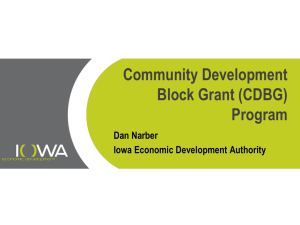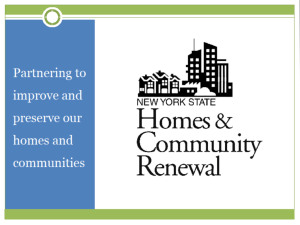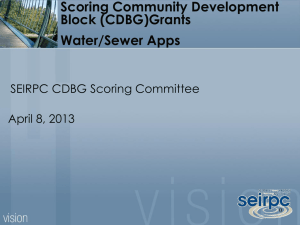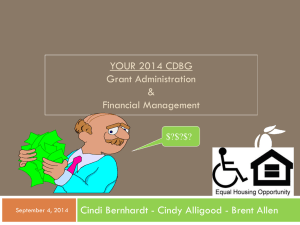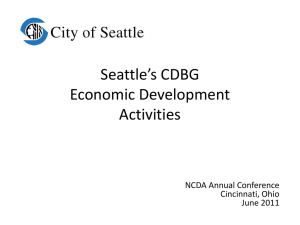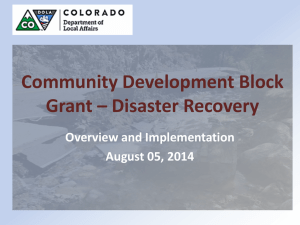Not - National Community Development Association
advertisement
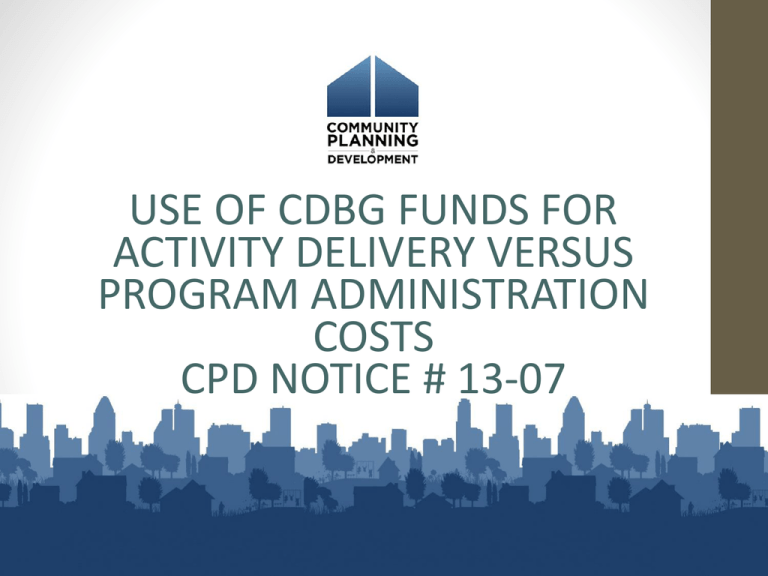
USE OF CDBG FUNDS FOR ACTIVITY DELIVERY VERSUS PROGRAM ADMINISTRATION COSTS CPD NOTICE # 13-07 WHAT WE’LL COVER TODAY: • • • • • • Define & Differentiate PACs vs. ADCs Charging PACs or ADCs for other programs Con Plan & Environmental Costs Discontinued/Terminated Activities Compliance with the 20% Cap Urban County Considerations DIFFERENTIATING BETWEEN ACTIVITY DELIVERY COSTS (ADCS) AND PROGRAM ADMINISTRATION COSTS (PACs) WHAT ARE ADCs? ADCs are allowable costs incurred for implementing and carrying out eligible CDBG activities. The ADC covers the costs of staff directly carrying out the activity in addition to equipment and supplies that are necessary for successful completion of the activity. An ADC must be allocable to a CDBG-assisted activity or an activity that is CDBG-eligible, meets a national objective, and meets all other CDBG program requirements. ADCs are eligible as part of the cost of carrying out CDBG activities authorized under 24 CFR 570.201570.204. EXAMPLES OF ADCs Salaries of employees for the time devoted to implementing and carrying out specific eligible CDBG activities such as public services, rehabilitation of public facilities and improvements, or housing rehabilitation. • Salary of persons bagging up and distributing food at a food bank. • Salary of persons providing job training on basic computer skills and programs. • Salary of grantee or subrecipient staff renovating a community center or park. • Salary of housing rehabilitation specialists performing inspections on housing units rehabilitated with CDBG funds. EXAMPLES OF ADCs (CONT.) The cost of materials acquired, consumed, or expended by staff in carrying out specific eligible CDBG activities. • Paper for housing rehabilitation program applications. • File cabinets used for filing applications for CDBG assistance. • Uniforms for code enforcement staff working in eligible areas. EXAMPLES OF ADCs (CONT.) Travel costs incurred specifically for carrying out eligible activities. • Visits to sites where housing rehabilitation activities are conducted to check work progress and final inspections of completed work. • Depreciation and use allowances for vehicles used to conduct code inspections and enforcement in CDBGeligible areas. NOTE: CDBG funds may only be used to pay for travel costs related to CDBG assisted activities and not for travel costs in general. WHAT ARE PACs? PACs are costs for staff-time and overhead costs for planning and general administration of the CDBG program. PACs cover the cost of planning, general management, oversight, coordination, and implementation of the CDBG program as a whole. Eligible planning and administration costs for the CDBG program may be found at 24 CFR 570.205 and 570.206. EXAMPLES OF PACs • Salaries of executive officers and staff with general program oversight responsibilities such as Community Development Directors, Planners, and their administrative staff. • Leased office space for staff employed in carrying out the CDBG program. • Time spent developing general CDBG program policies and procedures, such as CDBG application assistance procedures and development of procedures for monitoring subrecipients for overall CDBG program performance. • Staff time spent for the development of the Consolidated Plan/Action Plan and Consolidated Annual Performance and Evaluation Report. EXAMPLES OF PACs (CONT.) • Dissemination of information on the CDBG program, eligible activities, and how to apply. • Dissemination of education on fair housing. • Costs of data gathering and studies on the need for a park in a CDBG-eligible area. • Administration of HOME program activities. CHARGING ADCs FOR OTHER CONSOLIDATED PLAN FORMULA PROGRAMS (HOME, ESG, HOPWA) TO CDBG OTHER CONSOLIDATED PLAN FORMULA PROGRAMS – HOME, ESG, AND HOPWA CDBG funds may be used for ADCs in conjunction with other Consolidated Plan formula programs, which are: • HOME Investment Partnerships Program (HOME) • Emergency Solutions Grant (ESG) • Housing Opportunities for Persons With AIDS (HOPWA) OTHER CONSOLIDATED PLAN FORMULA PROGRAMS – HOME, ESG, AND HOPWA ADCs for HOME, ESG, and HOPWA-assisted activities must be for activities that are CDBG eligible and meet a national objective. The activities may be solely assisted with HOME, ESG, or HOPWA funds or assisted with CDBG and HOME, ESG, or HOPWA funds. Any activity assisted in whole or in part with CDBG funds is subject to all CDBG rules and federal requirements in addition to the rules of the other grant programs. THE HOME PROGRAM CDBG funds may be used to pay for housing services in support of HOME-assisted projects. This provision is codified in the CDBG regulations at 24 CFR 570.201(k). Eligible HOME housing services include: • housing counseling in connection with tenant-based rental assistance • energy auditing • work specifications and architectural plans • loan processing • tenant selection, and • other services related to assisting owners, tenants, third party entities participating or seeking to participate in a HOME project. THE ESG & HOPWA PROGRAMS Activities that are eligible under the ESG and HOPWA programs that are also eligible under the CDBG program include: • • • • • • • • • street outreach mental health care homeless services transportation of unsheltered persons emergency health services life skills training job training security deposits renovation of buildings to be used as emergency shelter for the homeless • housing counseling THE ESG & HOPWA PROGRAMS (CONT.) • acquisition, rehabilitation, conversion, lease and repair of facilities to provide housing • health care for the person with AIDS • drug/alcohol abuse treatment and counseling • nutritional services • supportive services such as day care THE ESG AND HOPWA PROGRAMS (CONT.) All of these activities except the building renovation and acquisition and lease of space for housing are considered CDBG-eligible public services. However, for a public service to be eligible for CDBG assistance, it must be either: • A new service or • A quantifiable increase in the level of an existing public service above that which has been provided by or on behalf of the unit of general local government in the 12 calendar months before submission of the Action Plan. • CDBG-assisted public service expenditures are limited to not more than 15 percent of a grantee’s annual CDBG grant plus 15 percent of its prior year’s program income. THE ESG AND HOPWA PROGRAMS (CONT.) • Acquisition of property via lease (for CDBG program purposes, must be for at least 15 years or more) and repair of properties for housing may qualify as either rehabilitation of public facilities under 24 CFR 570.201(c) if the intent is to only provide transitional housing. • If the intent is permanent housing, then the acquisition and repair of properties would be considered housing rehabilitation under 24 CFR 570.202(a). THE ESG AND HOPWA PROGRAMS (CONT.) INELIGIBLE ACTIVITIES ESG-eligible activities such as the payment of last month’s rent, utility payments up to 24 months, and short- and medium-term rental assistance are not eligible in the CDBG program. Therefore, no CDBG funds may be used to pay the ADCs of these activities. HOPWA-eligible activities such as project or tenant-based rental assistance; new construction of single room occupancy dwellings (unless carried out by a qualified CBDO); and short-term rent, mortgage, or utility payments that do not meet the criteria at 24 CFR 570.207(b)(4) are not eligible in the CDBG program. Therefore, no CDBG funds may be used to pay the ADCs of these activities. CHARGING ADCs FOR OTHER CPD PROGRAMS (HOMELESS PROGRAMS, HMIS, EZs, ECs and RCs) AND OTHER FEDERAL PROGRAMS TO CDBG OTHER CPD PROGRAMS • Homeless Programs-Consolidation of Supportive Housing Program (SHP), Shelter + Care (S+C), and Section 8 Moderate Rehabilitation Single Room Occupancy (SRO) Program • Homeless Management Information System (HMIS), Empowerment Zones (EZs) • Enterprise Communities (ECs) • Renewal Communities (RCs) NOTE: In 2009, implementation of the HEARTH Act combined the SHP, S+C, and Section 8 SRO Programs into one program, now known as the CoC Program. The Section 8 SRO Program component is no longer eligible under the CoC Program. However, there is a SRO component that is now part of the S+C program. OTHER CPD PROGRAMS – HOMELESS PROGRAMS - SHP Activities that are eligible under SHP that are also eligible under the CDBG program include: • Supportive services that facilitate the movement of homeless participants to independent living such as outreach, childcare, job training/placement, health care, and transportation. • Costs for operation of a supportive housing facility such as maintenance and repair, equipment, supplies, insurance, food, and furnishings. • Acquisition or lease of property to construct or rehabilitate supportive housing for homeless persons. OTHER CPD PROGRAMS – HOMELESS PROGRAMS – S+C An activity that is eligible under the S+C Program that is also eligible under the CDBG Program include supportive services, which are: • • • • • • • Health care Mental health treatment Alcohol/drug abuse treatment Childcare Counseling Education services Job training/placement. All of these are CDBG-eligible public services. OTHER CPD PROGRAMS – HOMELESS PROGRAMS – S+C INELIGIBLE ACTIVITIES • Rental assistance in connection with the moderate rehabilitation* of single room occupancy units • Project- and Sponsored-based rental assistance. *The rehabilitation must be paid for with another funding source. CDBG funds may be used for rehabilitation of SRO units and common areas. This would be considered rehabilitation of a public facility in accordance with 24 CFR 570.201(c). OTHER CPD PROGRAMS - HMIS CDBG Funds may be used to support HMIS only if: • The HMIS costs are activity delivery costs of a public service activity in accordance with 24 CFR 570.201(e). • The grantee must be carrying out a CDBG-eligible public service that meets a national objective. • Examples of eligible CDBG costs would include staff time using HMIS for client case management for services being provided to homeless persons, or relating to the operation of a homeless shelter. OTHER CPD PROGRAMS: EZs, ECs, AND RCs • The EZ and RC designations have expired. • There are currently 30 EZs remaining. Eligible EZ activities that are also eligible under the CDBG program include: • Assistance to businesses. • Assistance to establish or expand a business. • Establishment and expansion of microenterprises. • Services such as job training, child care, and job-related counseling (e.g., interviewing skills). • Public improvements such as water and sewer and street widening if they are impediments to the establishment, expansion, or retention of one or more businesses in the EZ. OTHER FEDERAL PROGRAMS CDBG funds may be used to pay ADCs for other Federal programs such as • Child and Adult Care Food Program administered by the Department of Agriculture • Head Start Program administered by the Department of Health and Human Services • Child Nutrition Programs (breakfast, lunch, and summer food programs) administered by the Department of Agriculture • Low Income Home Energy Assistance program administered by the Department of Health and Human Services To be eligible for CDBG assistance, the activity must be in a Consolidated Plan/Action Plan or amended Plan, eligible, meet a national objective, comply with environmental review procedures, cost principles at 2 CFR Part 200, and meet Davis-Bacon labor standards, if applicable. The statute and regulations for each of these programs should be consulted to ensure there are no requirements that conflict with CDBG program requirements. ELIGIBLE ADCs FOR CONSOLIDATED PLAN FORMULA PROGRAMS, OTHER CPD PROGRAMS, AND OTHER FEDERAL PROGRAMS Eligible ADCs for CDBG-eligible public services, public facilities and improvements, housing rehabilitation, economic development, and assistance to microenterprises assisted with ESG, HOPWA, CoC Programs (S+C and SHP), EZ, and other federal programs include but are not limited to: • Salaries of drivers conducting street outreach or providing transportation services, life skill instructors, health care workers, job trainers, mental health counselors, and security deposit intake workers. Only the salaries of the employees delivering the services (rather than an Executive Director or Chief Operating Officer) are eligible as part of carrying out the underlying public service. In addition, salaries may only be paid with CDBG funds proportionate to the amount of time spent working on CDBG-eligible activities. • Rental of space in buildings for the provision of public services such as mental and health care. ELIGIBLE ADCs (CONT.) • Materials such as computers, pens, paper, etc. needed for like skills and job training courses. • Depreciation and use allowances for vehicles needed for street outreach and transportation services. • Supplies such as beds, tables, and other furniture for shelters serving the homeless and persons with AIDS. • Desks, chairs, and other furnishings for businesses and microenterprises. • General office supplies for businesses and microenterprises such as computers, paper, pens, pencils, staplers, paper clips, etc. • Computers used for job training on Microsoft Office programs. CHARGING PACs FOR OTHER CONSOLIDATED PLAN FORMULA PROGRAMS TO CDBG OTHER CONSOLIDATED PLAN FORMULA PROGRAMS - HOME CDBG funds may be used to pay PACs for the HOME program. Section 105(a)(13) of the Housing and Community Development Act of 1974 and 24 CFR 570.206(i) state that CDBG funds may be used to pay costs for carrying out the overall administration of the HOME program. This authority also covers overall management and administration costs for implementation of activities that are not eligible under the CDBG program such as tenant based rental assistance and new housing construction. OTHER CONSOLIDATED PLAN FORMULA PROGRAMS – ESG AND HOPWA • CDBG funds may not be used to pay the costs of administration and management of the ESG and HOPWA programs nor the salary of a staff person in a general administrative position that works only on the administration of the ESG or HOPWA programs. • The Housing and Community Development Act of 1974 does not authorize the use of CDBG funds to pay program administration costs for ESG and HOPWA program administration. OTHER CONSOLIDATED PLAN FORMULA PROGRAMS – ESG AND HOPWA (CONT.) Exceptions CDBG funds may be used for staff administration costs associated with eligible ESG and HOPWA activities (such as homeless services, health screening, or job training) if the activities carried out are otherwise CDBG eligible and meet all CDBG requirements (e.g., eligibility, national objective compliance, and environmental review requirements). If a staff person that spends the majority of his/her time administering the CDBG program and a small part of his/her time carrying out general administrative functions for the ESG or HOPWA programs, CDBG funds may be used to pay his/her salary for the administrative staff time allocable to the CDBG program and for administration of the CDBGeligible ESG and HOPWA activities. CHARGING PACs FOR OTHER CPD PROGRAMS (HOMELESS PROGRAMS, HMIS, EZs, ECs, RCs) AND OTHER FEDERAL PROGRAMS TO CDBG OTHER CPD PROGRAMS - HOMELESS PROGRAMS, HMIS, EZs, ECs, RCs Homeless Programs – CoC Program – SHP and S+C • CDBG funds may not be used to pay the costs of administration and management of the SHP and S+C programs nor the salary of a staff person in a general administrative position that works only on the administration of the SHP and S+C programs. • The Housing and Community Development Act of 1974 does not authorize the use of CDBG funds to pay program administration costs for SHP and S+C program administration. OTHER CPD PROGRAMS - HOMELESS PROGRAMS, HMIS, EZs, ECs, RCs Homeless Programs – CoC Program – SHP and S+C Exception • CDBG funds may be used for PACs associated with eligible SHP and S+C activities (such as supportive services) if the activities carried out are otherwise CDBG eligible and meet all CDBG requirements (e.g., eligibility, national objective compliance, and environmental review requirements). • No CDBG funds may be used to pay for PACs for activities that are eligible under the S+C program (such as rental assistance) but are ineligible under the CDBG program. OTHER CPD PROGRAMS - HOMELESS PROGRAMS, HMIS, EZs, ECs, RCs HMIS CDBG funds may not be used to pay for the administration of HMIS because CDBG funds may not be used to pay the general administrative costs of the ESG program or other homeless programs under the authority of 24 CFR 570.206. HMIS is primarily for the collection of data for CoC Program assisted homeless programs and is not a data source for CDBG-assisted activities that benefit homeless persons. OTHER CPD PROGRAMS - HOMELESS PROGRAMS, HMIS, EZs, ECs, RCs EZs, ECs, and RCs CDBG funds may be used to pay planning and administration costs for the overall administration of a federally designated EZ or EC. [Section 105(a)(13) of the HCDA and 24 CFR 570.206(i)] CDBG funds may not be used to pay planning and administration costs for RCs because they are not included as eligible communities under the statutory or regulatory provisions governing the CDBG program. OTHER FEDERAL PROGRAMS CDBG funds may not be used to pay the planning and administration costs for the overall administration of other federal programs, even if some of the activities are CDBG-eligible and meet a national objective. CONSOLIDATED PLAN PROGRAM ADMINISTRATIVE COSTS The CDBG Program May be Charged the Entire Program Administrative Costs of: • • • • Development of Consolidated Plan/Action Plan Analysis of Impediments to Fair Housing Development of CAPER Efforts to Affirmatively Further Fair Housing Keep In Mind: • Must comply with 20% cap • Planning costs vs. Program Admin Costs • Some AFFH activities may be public services, not PACs • The 3-5 year ConPlan cost “bump” ENVIRONMENTAL COSTS Environmental Costs as PACs vs. ADCs Planning Costs under 570.205: • General Environmental/Urban Design/Historic Preservation Studies & Plans; Remediation Plans Activity Delivery Costs: • Activity-Specific assessments & clearances • Activity-Specific Remediation Plans Activity-Specific Environmental Review Costs Can be Charged as Planning Costs…why would you want to? • Is there a specific activity yet? • ADCs must meet a national objective • What if the activity never goes forward? ACTIVITY DELIVERY COSTS INCURRED FOR DISCONTINUED/TERMINATED ACTIVITIES ARE ADCs FOR DISALLOWED/ TERMINATED ACTIVITIES ALLOWED Grantees have two options with regard to ADCs for disallowed/terminated activities. • Charge the ADCs as PACs if the 20 percent planning and administration cap will not be exceeded. • Repay to its CDBG line of credit or program account the amount spent for the ADCs. COMPLYING WITH THE 20% PLANNING + ADMIN CAP The 20% cap is not in the HCDA, it’s in each year’s appropriation act 20% OF WHAT PER YEAR? • Computed for all expenditures/obligations during each program year • 20% of the sum of your grant + program income received during that program year • Grantee + all subrecipients combined • All such funds, regardless of the source FY WHAT COUNTS AGAINST THE CAP? • Planning costs under 570.205 • PACs under 570.206 • Not ADCs! Sum of: • Expenditures This Program Year • - Unliquidated obligations as of the end of last program year • + Unliquidated obligations at end of this program year NONCOMPLIANCE • This is a statutory requirement • HUD no longer allows grantees to “make up” for noncompliance by under-obligating in a future year • In other words, if you exceed the cap, you will have to reimburse your CDBG program account or Line of Credit • Importance of accurately tracking program income • Again, keep in mind the 3-5 year ConPlan cost “bump” SPECIAL CONSIDERATIONS FOR URBAN COUNTIES MOST URBAN COUNTIES WEAR TWO HATS AT ONCE • The County = the Grantee – has the general costs of administering the grant (ConPlan, CAPER, AFFH, Single Audit, etc.) • A County may implement activities itself & thus have ADCs for those activities • Most counties distribute funds to UGLGs – the UGLGs have ADCs for those activities • A County’s general oversight of the UGLGs & their activities is a PAC • The County might also incur ADCs for activities that UGLGs carry out - e.g. the county performs the environmental review, labor standards, relocation/ acquisition responsibilities for UGLGs

